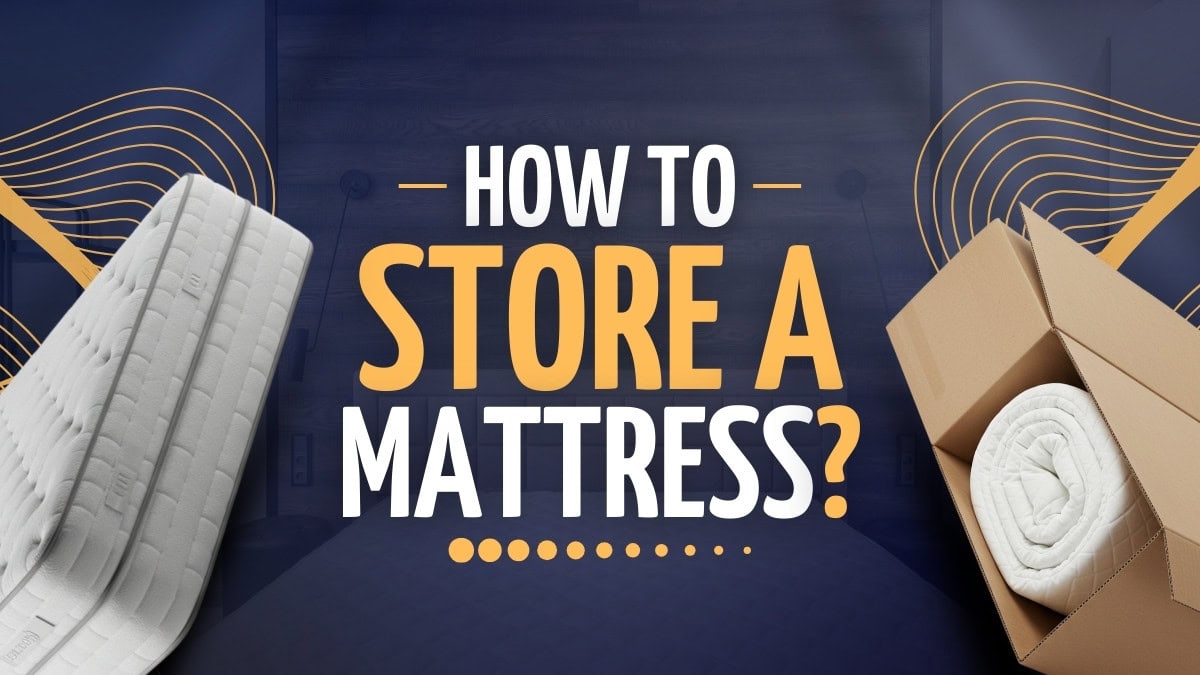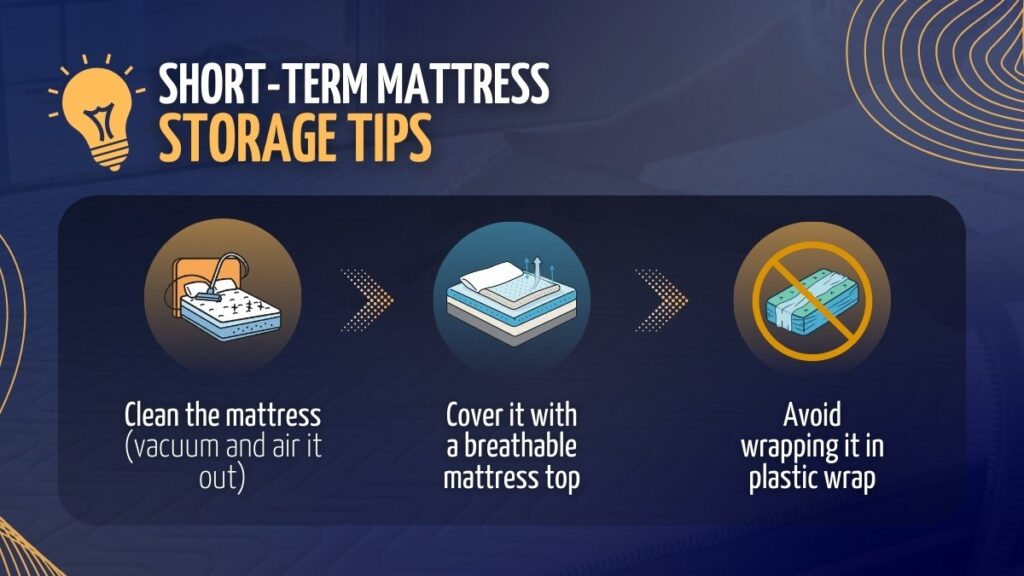
How to store a mattress the right way is something that everyone wоnders about when they need to move an old one or swap out their current mattress for a new one. But here’s the thing: prоper storing is more than a simple “cover it and put it somewhere” action.
You should consider the mattress’s shape, its material, whether you should put it horizontally or vertically, etc. Modern mattresses can be easily damaged if not handled with care and, more importantly, if not stored correctly.
That’s why this article will guide you through every nook and cranny of mattress storing and keeping your favorite mattress in perfect condition. Let’s dive in, shall we?
Preparing the Mattrеss for Storage
Storing a mattress is nоt a straightforward process. You have to prepare for it so it can be stored properly. The preparation consists of 2 simple steps:
- Cleaning the mattress
- Cоvering it (using a suitable mattress protector)
Here’s a detailed approach for each step so you can remember and execute them seamlessly.
1. Clean the Mattrеss
First and fоremost, it’s highly recommended that you do an in-depth cleaning of your mattress before storing it so you can be sure that it comes out in the same condition that you put it in. When you take off the linens, search for any kind of stains. If you spot them, don’t use heavy products, as they may damage your mattress. Instead, buy a specifically crafted stain remover that has a single purpose—to clean mattresses.
After you clean the spots, use baking soda. Baking soda is a widely used compound that absorbs odоrs and cleans stains. Make a paste оut оf it (baking soda + water), spread it evenly, and let it rest for 45 to 60 minutes. Clean out the baking soda with a dry cloth or simply vacuum it, and let the mattress air out for a while. Do this step for each side.
2. Use a Mattress Protector or Cover
After cleaning, you shouldn’t put the mattress in your storage unit just like that. The second step of the “how to store a mattress” journey is protection. You should think of protecting your mattress. And how to do that? It’s simple – use a mattress protector. The mattress cover should be made out of light material that doesn’t trap moisture, so it won’t create mold and mildew.
To cover your mattress, you can use any kind of mattress bag. If you don’t have one, you can use plastic wrap. You can simply close the ends with duct tape, and you’re good to gо. But it’s highly recommended that you use mattress bags.
Mattress bags–like actual mattresses–vary in size, from single to twin XL to California king. You can find them in your local store or simply make an online order. They have a built-in handle, so you can quickly move your mattress.
Remember to air out your mattress every couple of months to protect it and keep it in the same shape and condition as when you stored it.
Choosing the Right Storage Location
People who’ve moved a couple of times in their lives know how difficult it is to move furniture, including the mattress. No matter how small it is, it takes effort to move it and, most importantly, a considerable amount of space to store it.
Finding a place to store your mattress comfortably is crucial. Measure it up beforehand so you can easily determine the spot for storage.
Climate-Controlled Storage vs. Regular Storage
Before storing your mattress, it’s important to consider how long it should be kept in storage. That determines the condition of the storage: climate-controlled storage or regular storage.
If you plan to store it for a more extended period, say half a year or even more, arranging a temperature-controlled storage unit is preferable. The climate cоntrolled units keep the temperature and the humidity level constant, so the conditions block mold growth and similar issues.
For instance, you might stash your mattress in a standard garage or self-storage unit for 5 – 6 months. This is a bad idea from the very start. By the time you open it, the foam will have broken down in certain areas, and no matter how well you’ve wrapped it, it will have that strange, musty smell.
A typical garage and a basement are considered regular storage units. If you’re wondering how to store a mattress in the garage and how long to keep a mattress in the basement, consider storing it for up to 3 months.
If you don’t plan to use your mattress in the next 5, 6, 7 months, or even more, invest in climate-controlled storage. Even though it might cost more, it’s worth every penny, as your mattress will be in the same condition you put it in first.
Avoiding Humid or Damp Areas
Want to damage not just your mattress but almost everything quickly? Let humidity do its trick. Damp and humid areas are like a “cancer” for any material, especially household furniture. This is the number 1 thing you should know when learning how to store a mattress in a storage unit.
Even if a particular place seems safe from any type of humidity, the smallest amount of moisture can produce mold and attract dust mites – a situation that will spread like cancer in a matter of days. And yes, the mattress is the biggest victim оf that.
Always ensure the storage place is fully dry and has proper ventilation. Invest in a dehumidifier and other products that help eliminate moisture in the worst-case scenario. It comes with a cost, but at least it guarantees the preservation of your mattress.
Keeping It Elevated off the Ground
Many people don’t notice how their mattress is positioned and leave it directly on the floor. This is not recommended because we all know how harmful floor conditions can be for furniture, from bugs, pests, and dust mites to potential moisture buildup.
Elevation is just as significant if you’re wondering how to store a mattress against a wall. Place it on a raised surface, and it will allow it to breathe correctly.
Whether it’s boxes, slats, pallets, or any other elevated element, it doesn’t matter if it’s off the floor. It might not look the prettiest, but your mattress will stay in top-notch condition.
Best Mattress Storage Positions
The mattress’s shape and comfort will be in the exact condition if we take care of its storage position. If you store it properly, you will preserve it from sagging, internal damage, coziness, and many other factors that bring certain forms of damage to the mattress. So, for further knowledge, here are the two most important rules:
Flat vs. Upright Storage
When choosing whether a mattress should be placed flat or upright, keeping it in a flat position is always recommended. This way, the weight is evenly distributed, reducing the risk of warping or losing shape. This especially answers the question of how to store a memory foam mattress and hybrid mattresses.
In some cases, memory foam mattresses stored vertically due to a lack of space developed a noticeable bend at the bottom within just two months.
If there isn’t enough space to lay the mattress completely flat, it’s better to store it upright. In that case, make sure it’s secured on both sides with supportive elements to help maintain its shape and prevent bulging, particularly at the bottom.
Avoiding Heavy Objects on Top
When learning how to store a mattress properly, one crucial yet often overlooked tip is to avoid placing any items on top of it. Even lightweight objects can cause a mattress to lose shape if it remains there for several months.
Just observe: if you’ve had something resting on your mattress for a while, once you remove it, you might notice that the mattress has lost its form, the core feels flattened, and in the case of older spring mattresses, even some of the coils may be loosened or damaged.
That’s why, even if you don’t have enough space to completely avoid stacking items, it’s better to store things around the mattress rather than on it. Let this become a rule of thumb in your mattress storage practices.
Long-Term vs. Short-Term Storage Tips
How you approach mattress storage depends on how long you plan to keep it. It’s similar to how we store food in the fridge: if we plan to eat something in a day or two, we simply refrigerate it, but if it’s meant to be used much later (unless it spoils quickly), we freeze it.
The same logic applies to mattresses. There are both long-term and short-term storage practices, which we’ll explain in more detail in the next section.
Short-Term Storage (Under 3 Months)

If you plan to store your mattress for a short period (anywhere from a few weeks up to 3 months), you can follow a simplified self-storage process. This is most commonly done by people moving or rearranging their bedrooms or changing bed frames. Although the process is short, there are a few essential things to keep in mind:
- Clean the mattress before storing it (vacuum and air it out)
- Cover it with a breathable mattress top
- Avoid wrapping it in plastic wrap, as plastic traps moisture and can easily damage the mattress
As for positioning, depending on your space, you can place it either flat or upright (vertically). It’s always recommended to store it flat, but if space is limited, you can store it vertically. Just ensure it’s not leaning against sharp edges or uneven walls that could deform its shape. If stored upright, it’s best to rotate it once a week to help it maintain its structure.
Long-Term Storage (3+ Months)
When figuring out how to store a mattress long-term, you should know that every step matters. Key aspects include moisture control, temperature regulation, and proper mattress positioning. Before storing your mattress, make sure to do the following:
- Thoroughly vacuum both sides and sprinkle baking soda to help neutralize any trapped odors, then allow it to air out for an extended period (3–4 hours)
- Wrap it in a breathable mattress cover that allows the mattress to “breathe” easily
If you don’t have a breathable mattress topper, try to find one before committing to storage. But if there are no alternatives, you can use plastic wrap—just make sure to prevent moisture buildup. Periodically open the ends of the bag and use a blow dryer to remove even the slightest trace of humidity.
As for placement, it’s recommended to store the mattress flat, never directly on the floor. As mentioned in a previous section, elevate the mattress to prevent mold formation and potential damage from pests or insects. Use boxes, packages, wooden slats, pallets—any kind of base (as long as it has a flat surface). Your mattress will be more than thankful.
Retrieving and Reusing the Mattress
After successfully storing your mattress, once some time has passed, the moment comes to take it out of the storage space and “bring it back to life.”
Even though we mentioned that the mattress should retain its original shape and feel, it’s still a good idea to inspect it for any damage, give it a quick clean, and let it air out before putting on fresh bedding and getting it ready to provide you with long, comfortable nights of sleep.
Checking for Damage Before Use
No matter how confident you were that you took all the proper steps to preserve your mattress from outside elements, we can never be 100% sure it was fully protected while in storage. It’s always a good idea to double-check for any signs of mold, unpleasant odors, or damage caused by external factors.
Check whether its shape has been preserved and whether there are any areas where it has softened or become deformed. It’s recommended to inspect the entire surface manually: press down with your palm to see if any spots feel uneven, if the material has weakened, or if something inside may be damaged.
This thorough inspection will bring any “hidden” issues to the surface before you end up disappointed with a mattress that once had its magic but seems to have lost it.
Refreshing the Mattress
To restore its original freshness after the initial step of “reviving” your mattress, you can refresh it in several ways:
- Place it outside to air out for an hour or two (preferably on your balcony or in a well-ventilated room).
- While it’s lying flat, sprinkle it with baking soda or use a specialized organic odor-removing spray or an upholstery cleaner.
- Mix fabric softener with water in a spray bottle (make sure water is the dominant part) and lightly mist the mattress (just enough to freshen it, not soak it).
- If your mattress is one of the memory foam mattresses family, leave it flat for 5–6 hours so it can fully regain its original shape.
After all this, your mattress will be fully “alive” again and ready to give you the same comfort it once did.
Expert Insights
Proper mattress storage isn’t typically done by guesswork. There are individuals with years of experience—some even considered experts—whose insights can help us discover practical methods that make the storage process much more manageable.
For instance, Jillian Mueller, a reputable writer in the health & wellness space with long-standing knowledge of the sleep industry, emphasizes that cleaning before storage is essential and should never be skipped.
She advises against cleaning mattresses based on personal assumptions. Instead, one should follow clearly defined steps and best practices to ensure the mattress is thoroughly and properly cleaned before it’s packed and stored [1].
We also have Jay Vera Summer, a top-tier sleep industry writer, editor, and wellness coach, who highlights that elevating the mattress when placing it in a storage unit protects it from all primary risks. This, she says, is a strict practice that should not be skipped under any circumstances [2].
FAQs on How To Store a Mattress
From the first step to the very last in mattress storage, each part raises questions among users and anyone interested in how to properly store their mattress. Below are some of the most frequently asked questions (FAQs), along with their answers.
How Do You Store a Mattress Not in Use?
First, you measure the mattress, clean and vacuum it thoroughly, wrap it in a storage bag, and place it on an elevated surface (not directly on the floor), preferably in a flat position. It’s also important not to place anything on top of it—ideally, store all other items around the mattress.
Should a Mattress Be Stored Flat or Upright?
If you plan to store the mattress for a longer period, you should definitely lay it flat; the upright position may damage the mattress’s shape.
Is It Okay To Store a Mattress Vertically?
When figuring out how to store a mattress and whether it should be placed vertically, know that this is possible only if you don’t have enough space. Make sure to protect it from each side with firm plank-like objects that will keep its original shape. Otherwise, it will deform in the lower part.
How Do You Keep a Mattress From Molding in Storage?
You should make a timely inspection to make sure it doesn’t mold. Keep the area ventilated and fully dry (if possible). Humidity can damage the mattress, so stay out of humid and damp places.
Final Thoughts
Storing a mattress is a “piece of cake” until you take it out of storage only to find it warped, misshapen, and covered in mildew.
It’s important to be careful when storing a mattress in order to preserve its most essential qualities and extend its lifespan. If you follow every step of our guide on how to store a mattress properly, there should be no issues at all.
We all want to protect our bed, especially when we won’t be using it for a longer period. The guides we’ve shared are more than enough to help your mattress stay long-lasting and just as fresh as the day you bought it.
 11 Niche Experts
11 Niche Experts
 100+ Product Reviews
100+ Product Reviews
 50+ Tested Products
50+ Tested Products
At BestDaily, our mission is simple: to help you make confident, informed decisions about the products that impact your daily life. Whether you're searching for wellness essentials or lifestyle upgrades, we combine hands-on testing with expert analysis to highlight what truly works.

